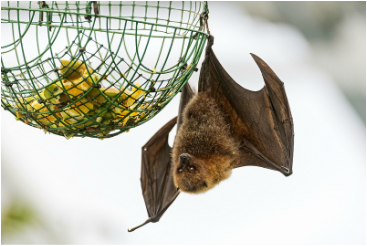
Okay, now that I have captured your attention with this TRUE headline, I would like you to ponder a few things… Considering the fact that fruit bats are mammals, and thus capable of becoming infected with the deadly Zaire strain of Ebola virus, what is it about the lifestyles of these “flying foxes” that may predispose them to asymptomatic (no-symptom) infection? Well, believe-it-or-not, based upon clinical research and a study of the lifestyle habits of African fruit bats, we can readily ascertain the reasons why Ebola infection may pose less threat to their physiologic function as well as learn how we also can win the fight against this dread illness… And the good news is: it’s so simple even a bat can do it!
Across the humid tropical highlands of sub-Saharan Africa, there flies a half dog-half bat looking creature on the lookout for his favorite meal. As he spies one of the local villagers he swoops down to devour his prey…. Okay let’s stop for a moment here. I know what you’re thinking: this bat-creature is about to sink its claws into the ruddy flesh of… a passion fruit, mango or jackfruit? Yes! These bats are fruitarian! While it is true the bat family, in general, have been given a bad rap (mostly due to the nasty habits of their blood-sucking South American constituents), fruit bats play an especially important role in the regional ecosystem. First of all, they spread fruit seeds far and wide in their guano (bat droppings) and secondly they help with pollination due to their tremendous appetites that keep them winging their way from tree to tree in search of food.
So, based upon what we already know about the fruit bat… what are some of the possible explanations as to why they are immune to the effects of Ebola infection? Well, for one, they are incredibly active: we know moderate physical exercise is essential in bolstering the immune response (1). Also, they rest in trees upside-down while eating, sleeping, etc. We may not need to live our lives in this state but an occasional incline, here or there, can really help increase lymphatic flow, which usually has to work against gravity, thereby bringing more lymph-based immune cells into general circulation (2). But there is something else about the bat’s lifestyle that, I believe, truly predisposes these creatures to victory in the battle over Ebola: a unique diet.
Scientists have been studying the Ebola virus since its debut in 1976, but still readily admit they have yet to find a “cure.” Strange information considering there are numerous published reports, in the medical literature, of Ebola being effectively “cured” in laboratory animals. Of special note are the studies using a complex known as mannose-binding lectin (MBL). This naturally occurring plant protein has been found to function as an opsonin: with the ability to reverse the opposing electrical charge of a pathogen and, thus, allow it to be “brought” to an immune cell (3,4,5). This process is similar to a police officer arresting and handcuffing a suspect (thereby minimizing potential threat) before the perpetrator is “brought in” to be tried by a court of law.
Another function of MBL is that it inactivates certain pathogens, such as Zaire Ebolavirus, by two specific means: 1) by directly “alter[ing] the function of microbial structures” (6); and 2) by causing the virus to bind to immune compounds known as complement, which “neutralize” the pathogen (5). In one study, published in 2011 in the Journal of Infectious Diseases, mice who had seven times the average human blood levels of mannose-binding lectin survived “fatal Ebola virus infections and became immune to virus rechallenge” (4).
Furthermore, one of the primary goals of the Ebola virus is to infect the first-contact immune alert system (known as the dendritic cells) and use other secondary responder immune cells as a vehicle to spread throughout the body (6). In one study, published in the September 2003 edition of the journal Immunology, researchers discovered that mannose-binding lectin stops the spread of viruses (in this case the HIV virus) from infected dendritic cells to T-cells (7). What does this mean? Well, if you can stop a virus from infecting and disabling the immune system, the immune system can, in turn, have greater potential to attack and destroy the virus!
So, by now you may be wondering: where do bats come into this equation? Well, FRUIT bats, eat a lot of… well… FRUIT (8)! Not by coincidence, these fruit are naturally high in the sugar known as mannose as well as MANNOSE-BINDING LECTINS to hold these sugars structurally in place (9). Why is the Ebola virus spreading out of control in Africa? For one reason, officials are warning Africans to stay away from fruit, which, they caution may be contaminated by these “Ebola-carrying” fruit bats. This looks like a quandary: how can Africans get enough MBL if they are afraid of fruit?
Here’s the easy solution: firstly, eat plenty of fruit but avoid those that have obvious bite marks (a good practice in general), but secondly, it turns out that there are also other rich sources of MBL throughout the vegetable world (10). For example, all members of the Allium family (onions, garlic, leeks, shallots), and certain tubers (such as taro, or malanga) are naturally high in this potent compound (9). Interestingly, Nigeria is of the world’s largest commercial producers of taro (their neighbors are in need of some these timely tubers)!
With all this scientific weight of evidence, why isn’t natural mannose-binding lectin being used to prevent/ treat Ebola infections? Well, let us allow the researchers themselves to answer that question. An article recently published in the Journal of Biological Chemistry revealed that “MBL has a complex quaternary structure unsuitable for large scale cost-effective production” (3). There you have it… In laymen’s terms, it would not generate enough “[moola]” to be “[a worthwhile economic investment].” What?!?! Why is this world so often backwards in motive?
Bottom line is this: to truly benefit from these research findings we need to go to the bat to see how it’s done: eat our fresh fruits and vegetables, exercise moderately, live an out-of-doors life, and don’t worry when people blame YOU for something you are not responsible for…
By the way, the bat didn’t originate the cure for Ebola: “And God said, Behold, I have given you every herb bearing seed, which is upon the face of all the earth, and every tree, in the which is the fruit of a tree yielding seed; to you it shall be for [food]” Genesis 1:29.
The bats are listening… Are we?
P.S. Please pass this information on if you desire to positively affect your regional ecosystem & sign up for Prebola© today at healthislife.org!
References:
1) Exerc Immunol Rev. 2013;19:120-43.
2) J Am Osteopath Assoc. 2005 Oct;105(10):447-56.
3) J Biol Chem. 2010 Aug 6;285(32):24729-39. doi: 10.1074/jbc.M110.106260.
4) J Infect Dis. 2011 Jan 15;203(2):175-9. doi: 10.1093/infdis/jiq025.
5) J Gen Virol. 2005 Sep;86(Pt 9):2535-42.
6) Expert Opin Ther Targets. 2002 Aug;6(4):423-31.
7) Immunology. 2003 Sep;110(1):80-5
8) http://animaldiversity.ummz.umich.edu/accounts/Eidolon_helvum/
9) http://www.owenfoundation.com/Health_Science/Lectins_in_Foods.html
10) Biochimie. 2001 Jul;83(7):645-51.
Across the humid tropical highlands of sub-Saharan Africa, there flies a half dog-half bat looking creature on the lookout for his favorite meal. As he spies one of the local villagers he swoops down to devour his prey…. Okay let’s stop for a moment here. I know what you’re thinking: this bat-creature is about to sink its claws into the ruddy flesh of… a passion fruit, mango or jackfruit? Yes! These bats are fruitarian! While it is true the bat family, in general, have been given a bad rap (mostly due to the nasty habits of their blood-sucking South American constituents), fruit bats play an especially important role in the regional ecosystem. First of all, they spread fruit seeds far and wide in their guano (bat droppings) and secondly they help with pollination due to their tremendous appetites that keep them winging their way from tree to tree in search of food.
So, based upon what we already know about the fruit bat… what are some of the possible explanations as to why they are immune to the effects of Ebola infection? Well, for one, they are incredibly active: we know moderate physical exercise is essential in bolstering the immune response (1). Also, they rest in trees upside-down while eating, sleeping, etc. We may not need to live our lives in this state but an occasional incline, here or there, can really help increase lymphatic flow, which usually has to work against gravity, thereby bringing more lymph-based immune cells into general circulation (2). But there is something else about the bat’s lifestyle that, I believe, truly predisposes these creatures to victory in the battle over Ebola: a unique diet.
Scientists have been studying the Ebola virus since its debut in 1976, but still readily admit they have yet to find a “cure.” Strange information considering there are numerous published reports, in the medical literature, of Ebola being effectively “cured” in laboratory animals. Of special note are the studies using a complex known as mannose-binding lectin (MBL). This naturally occurring plant protein has been found to function as an opsonin: with the ability to reverse the opposing electrical charge of a pathogen and, thus, allow it to be “brought” to an immune cell (3,4,5). This process is similar to a police officer arresting and handcuffing a suspect (thereby minimizing potential threat) before the perpetrator is “brought in” to be tried by a court of law.
Another function of MBL is that it inactivates certain pathogens, such as Zaire Ebolavirus, by two specific means: 1) by directly “alter[ing] the function of microbial structures” (6); and 2) by causing the virus to bind to immune compounds known as complement, which “neutralize” the pathogen (5). In one study, published in 2011 in the Journal of Infectious Diseases, mice who had seven times the average human blood levels of mannose-binding lectin survived “fatal Ebola virus infections and became immune to virus rechallenge” (4).
Furthermore, one of the primary goals of the Ebola virus is to infect the first-contact immune alert system (known as the dendritic cells) and use other secondary responder immune cells as a vehicle to spread throughout the body (6). In one study, published in the September 2003 edition of the journal Immunology, researchers discovered that mannose-binding lectin stops the spread of viruses (in this case the HIV virus) from infected dendritic cells to T-cells (7). What does this mean? Well, if you can stop a virus from infecting and disabling the immune system, the immune system can, in turn, have greater potential to attack and destroy the virus!
So, by now you may be wondering: where do bats come into this equation? Well, FRUIT bats, eat a lot of… well… FRUIT (8)! Not by coincidence, these fruit are naturally high in the sugar known as mannose as well as MANNOSE-BINDING LECTINS to hold these sugars structurally in place (9). Why is the Ebola virus spreading out of control in Africa? For one reason, officials are warning Africans to stay away from fruit, which, they caution may be contaminated by these “Ebola-carrying” fruit bats. This looks like a quandary: how can Africans get enough MBL if they are afraid of fruit?
Here’s the easy solution: firstly, eat plenty of fruit but avoid those that have obvious bite marks (a good practice in general), but secondly, it turns out that there are also other rich sources of MBL throughout the vegetable world (10). For example, all members of the Allium family (onions, garlic, leeks, shallots), and certain tubers (such as taro, or malanga) are naturally high in this potent compound (9). Interestingly, Nigeria is of the world’s largest commercial producers of taro (their neighbors are in need of some these timely tubers)!
With all this scientific weight of evidence, why isn’t natural mannose-binding lectin being used to prevent/ treat Ebola infections? Well, let us allow the researchers themselves to answer that question. An article recently published in the Journal of Biological Chemistry revealed that “MBL has a complex quaternary structure unsuitable for large scale cost-effective production” (3). There you have it… In laymen’s terms, it would not generate enough “[moola]” to be “[a worthwhile economic investment].” What?!?! Why is this world so often backwards in motive?
Bottom line is this: to truly benefit from these research findings we need to go to the bat to see how it’s done: eat our fresh fruits and vegetables, exercise moderately, live an out-of-doors life, and don’t worry when people blame YOU for something you are not responsible for…
By the way, the bat didn’t originate the cure for Ebola: “And God said, Behold, I have given you every herb bearing seed, which is upon the face of all the earth, and every tree, in the which is the fruit of a tree yielding seed; to you it shall be for [food]” Genesis 1:29.
The bats are listening… Are we?
P.S. Please pass this information on if you desire to positively affect your regional ecosystem & sign up for Prebola© today at healthislife.org!
References:
1) Exerc Immunol Rev. 2013;19:120-43.
2) J Am Osteopath Assoc. 2005 Oct;105(10):447-56.
3) J Biol Chem. 2010 Aug 6;285(32):24729-39. doi: 10.1074/jbc.M110.106260.
4) J Infect Dis. 2011 Jan 15;203(2):175-9. doi: 10.1093/infdis/jiq025.
5) J Gen Virol. 2005 Sep;86(Pt 9):2535-42.
6) Expert Opin Ther Targets. 2002 Aug;6(4):423-31.
7) Immunology. 2003 Sep;110(1):80-5
8) http://animaldiversity.ummz.umich.edu/accounts/Eidolon_helvum/
9) http://www.owenfoundation.com/Health_Science/Lectins_in_Foods.html
10) Biochimie. 2001 Jul;83(7):645-51.





 RSS Feed
RSS Feed